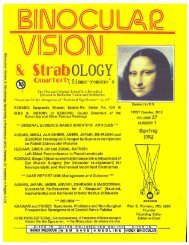Correspondence - ICO Library
Correspondence - ICO Library
Correspondence - ICO Library
Create successful ePaper yourself
Turn your PDF publications into a flip-book with our unique Google optimized e-Paper software.
-58-<br />
Binocular Vision & Inferior Oblique Muscle Palsy with ‘Paradoxical’ V-Pattern Strabismus FIRST Quarter of 2011<br />
Strabology Quarterly© E. Khawam, MD and D. Fahed, MD Volume 26 (No.1)<br />
A Medical Scientific e-Periodical Pages 51-60<br />
On external examination, the patient showed<br />
a face turn to the left (Figure 5, below) and, at<br />
times, a head tilt to the right shoulder.<br />
The presence of a habitual head tilt, the<br />
positive BHTT, the marked overaction of the<br />
antagonist SO muscle, and the improvement<br />
of elevation action of the IO muscle in<br />
adduction by duction compared to version all<br />
rule out Brown Syndrome (6). Forced duction<br />
test could not be done since the patient failed<br />
to return to our clinic as repeatedly requested<br />
and was therefore “lost to follow up”.<br />
A pseudo-V-pattern can occur if glasses<br />
are not worn, because correction reduces the<br />
deviation by an unequal amount in elevation,<br />
primary position, and depression. To avoid it,<br />
all our measurements were done with full<br />
optical correction at distance and near (11).<br />
A pseudo-V-pattern, as well as failure<br />
to diagnose a clinically significant A-pattern<br />
can be seen if accommodation is not<br />
controlled during measurements of the A- and<br />
V-patterns. That is due to the un-naturalness<br />
t o t h e s u b j e c t t o e x e r t<br />
accommodative effort in upward<br />
gaze, consequently resulting in a<br />
de-crease of accommodative convergence<br />
in that position (11). That<br />
was avoided by measuring the A-<br />
and V-patterns at the fixation<br />
distance of 6 meters.<br />
DISCUSSION<br />
A- and V-patterns manifested<br />
by a horizontal change of<br />
binocular alignment of the eyes<br />
from upgaze to downgaze are<br />
common (12). V-patterns are most<br />
commonly associated with IO<br />
muscle overaction and A-patterns<br />
with SO muscle overaction (13).<br />
Figure 5 (Khawam & Fahed):<br />
Our patient showing a 20 degree face turn.<br />
The principles advanced to<br />
explain the cause of A- and V-<br />
patterns are discussed in the<br />
literature by Costenbader (12) and<br />
Parks (13). However, “paradoxical”<br />
A- and V-patterns to the<br />
horizontal deviation are rare.<br />
There are few illustrating reports<br />
in the literature:









